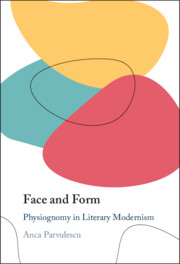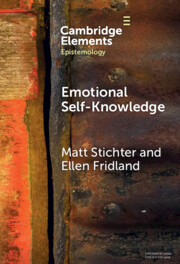Refine search
Actions for selected content:
344 results
4 - Resistance in Motion
- from Part II - Artistic Practices, Racism and Anti-Racism
-
-
- Book:
- Art and Anti-Racism in Latin America
- Published online:
- 19 December 2025
- Print publication:
- 29 January 2026, pp 137-163
-
- Chapter
-
- You have access
- Open access
- HTML
- Export citation
Chapter 1 - Reading and Revising the 1990s
-
- Book:
- The Cambridge Introduction to Queer and Trans Studies
- Published online:
- 24 November 2025
- Print publication:
- 18 December 2025, pp 19-53
-
- Chapter
-
- You have access
- HTML
- Export citation
Chapter 103 - Perceived Benefits of Thinness Scale (PBTS)
-
-
- Book:
- Handbook of Body Image-Related Measures
- Published online:
- 21 November 2025
- Print publication:
- 20 November 2025, pp 307-308
-
- Chapter
- Export citation
The Affective Politics of Police Mediation: Renqing, Resistance and Governance in Grassroots China
-
- Journal:
- The China Quarterly , First View
- Published online by Cambridge University Press:
- 14 November 2025, pp. 1-16
-
- Article
-
- You have access
- Open access
- HTML
- Export citation
Chapter 16 - Lithium in the Web of Life
- from Part III - Applications
-
-
- Book:
- Commodities and Literature
- Published online:
- 14 October 2025
- Print publication:
- 09 October 2025, pp 278-297
-
- Chapter
- Export citation
A Semiotics of Coziness and Disappearing Night
-
- Journal:
- Signs and Society ,
- Published online by Cambridge University Press:
- 08 October 2025, pp. 1-30
-
- Article
-
- You have access
- Open access
- HTML
- Export citation
Chapter 18 - Episodic Emotional Memory
- from Section IV - Emotional Learning and Memory
-
-
- Book:
- The Cambridge Handbook of Human Affective Neuroscience
- Published online:
- 16 September 2025
- Print publication:
- 02 October 2025, pp 363-382
-
- Chapter
- Export citation
Chapter 1 - Theories of Emotion for Human Affective Neuroscience
- from Section I - Theoretical Models of Emotion
-
-
- Book:
- The Cambridge Handbook of Human Affective Neuroscience
- Published online:
- 16 September 2025
- Print publication:
- 02 October 2025, pp 7-32
-
- Chapter
- Export citation
26 - Ethnography, Experience, and Coming of Age at the Margins
- from Part V - Postcolonial and Political–Economic Interventions
-
-
- Book:
- The Cambridge Handbook of Psychological Anthropology
- Published online:
- 22 October 2025
- Print publication:
- 25 September 2025, pp 629-648
-
- Chapter
- Export citation
19 - Emotion and Affect
- from Part IV - Body, Emotion, Self, and Experience
-
-
- Book:
- The Cambridge Handbook of Psychological Anthropology
- Published online:
- 22 October 2025
- Print publication:
- 25 September 2025, pp 460-482
-
- Chapter
- Export citation
Perceptions of Ethnic Minority Discrimination: Statistics and Stories Move Majorities
-
- Journal:
- British Journal of Political Science / Volume 55 / 2025
- Published online by Cambridge University Press:
- 27 August 2025, e116
-
- Article
-
- You have access
- Open access
- HTML
- Export citation

Face and Form
- Physiognomy in Literary Modernism
-
- Published online:
- 21 August 2025
- Print publication:
- 04 September 2025
-
- Book
-
- You have access
- Open access
- Export citation
Affective sovereignty: A decolonising politics of emotion in Palestine
-
- Journal:
- Review of International Studies , First View
- Published online by Cambridge University Press:
- 15 August 2025, pp. 1-23
-
- Article
-
- You have access
- Open access
- HTML
- Export citation
5 - Virtue, Transgression, and Value
-
- Book:
- The Language Work of Speechwriters
- Published online:
- 31 October 2025
- Print publication:
- 14 August 2025, pp 134-161
-
- Chapter
- Export citation
16 - The Role of Relative Deprivation in the Process of Radicalization into Violent Extremism
- from Part III - Group-Level Perspectives
-
-
- Book:
- The Cambridge Handbook of the Psychology of Violent Extremism
- Published online:
- 31 October 2025
- Print publication:
- 07 August 2025, pp 323-344
-
- Chapter
- Export citation
Chapter 3 - Antebellum Sensationalism; or, Melodramas of the Market
- from Part II - Histories
-
-
- Book:
- Money and American Literature
- Published online:
- 03 July 2025
- Print publication:
- 17 July 2025, pp 63-78
-
- Chapter
- Export citation
Validation of the cerebellar cognitive affective syndrome (CCAS) scale in CCAS patients and cerebellar controls
-
- Journal:
- Journal of the International Neuropsychological Society / Volume 31 / Issue 5-6 / June 2025
- Published online by Cambridge University Press:
- 14 July 2025, pp. 430-440
-
- Article
-
- You have access
- Open access
- HTML
- Export citation
Chapter 7 - Beckett’s Affective Telepoetics
-
- Book:
- Samuel Beckett and Medicine
- Published online:
- 20 June 2025
- Print publication:
- 03 July 2025, pp 135-150
-
- Chapter
- Export citation

Emotional Self-Knowledge
- How Affective Skills Reveal Our Values, Goals, Cares, and Concerns
-
- Published online:
- 09 June 2025
- Print publication:
- 03 July 2025
-
- Element
- Export citation
Voice as Constellation: Listening to the Voices and Silences of Displacement in Three Acts
-
- Journal:
- Royal Musical Association Research Chronicle ,
- Published online by Cambridge University Press:
- 28 May 2025, pp. 1-12
-
- Article
-
- You have access
- Open access
- HTML
- Export citation
